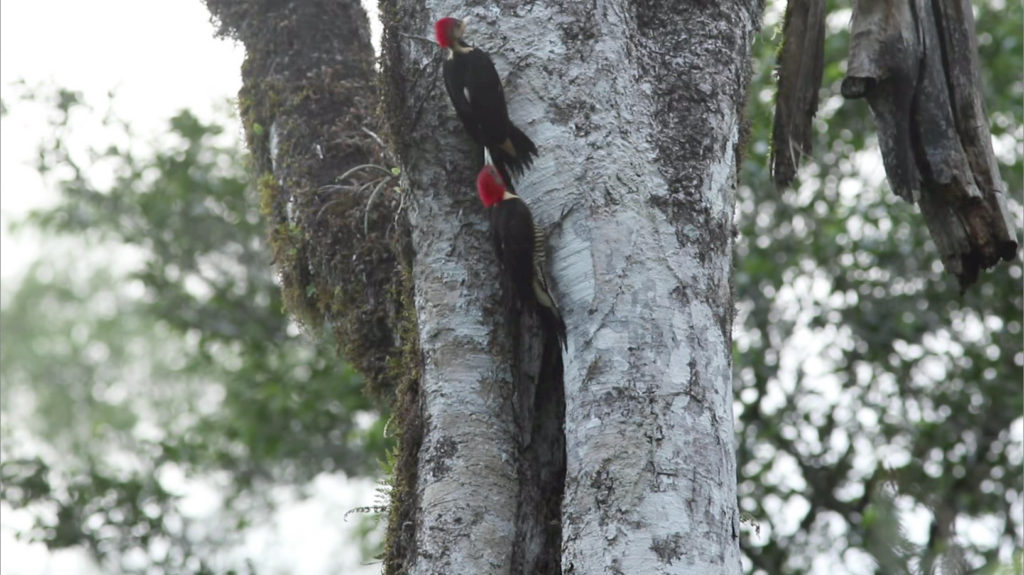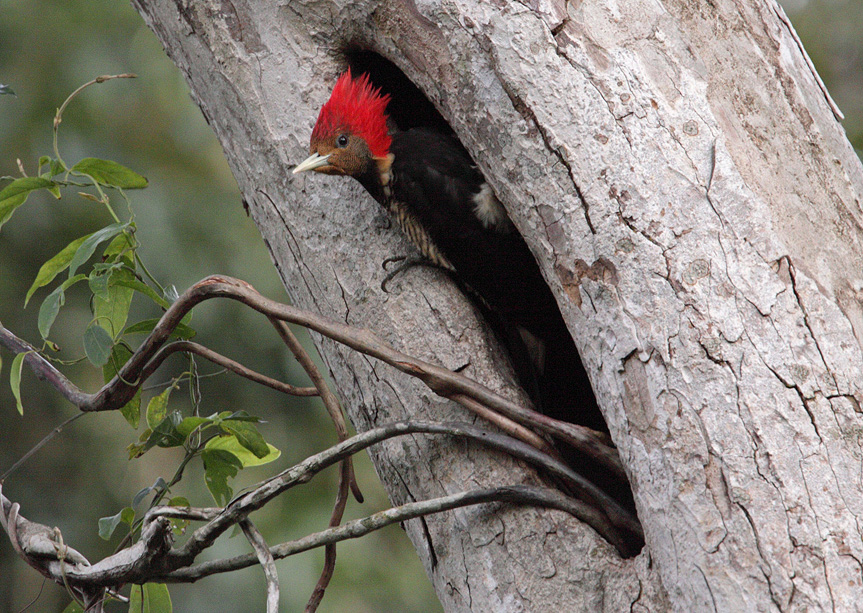Guest post by researchers Martjan Lammertink, Juan Manuel Fernández, and Kristina Cockle
Linked paper: Helmeted Woodpeckers roost in decay-formed cavities in large living trees: A clue to an old-growth forest association by M. Lammertink, J.M. Fernández, and K.L. Cockle, Jr, The Condor: Ornithological Applications 121:1, February 2019.
Woodpeckers make holes in trees. Don’t they?
Many species of woodpeckers depend on mature forest. Usually, it’s because they need large decaying or dead trees for foraging and excavating nest holes. Since they roost overnight in their old nest cavities, we usually don’t think about roost cavities as a separate consideration for conservation management.
The Helmeted Woodpecker (Celeus galeatus) is different. We know this globally vulnerable species is associated with well-preserved, native Atlantic Forest, but why? We radio-tracked Helmeted Woodpeckers in Argentina’s Misiones province to learn more about their foraging, nesting, and ranging ecology, as well as their coexistence with other woodpecker species. We expected their roosting behavior to follow the pattern of other woodpeckers, with roost sites predominantly in excavated cavities.
Not so. We found 21 roost cavities used by at least 15 individual Helmeted Woodpeckers. Incredibly, none of them were excavated. All of the roosts were in cavities formed by natural decay in large, usually living trees. This makes the Helmeted Woodpecker unique.
Helmeted Woodpeckers, it turns out, have a lot of unusual roosting habits. Although other woodpeckers descend into their cavity to roost, Helmeted Woodpeckers go up inside the cavity and cling to the wall above the entrance. After nesting, each parent takes a fledgling to its separate decay-formed roost cavity, where they roost together for up to 67 days. So they don’t just need decay-formed roost cavities, they need decay-formed roost cavities with sufficient interior space above the entrance for two individuals.
Helmeted Woodpeckers can excavate cavities – they do it for nesting. They often forage on small dead branches and bamboo stalks, which are common in disturbed forest patches. But these birds are found primarily in old forests, and the fact that they roost in decay-formed cavities, which occur mainly in large, old trees, may go a long way toward explaining this association.
The cavities that Helmeted Woodpeckers use as roosts are in high demand by other forest animals, too. We found eight other bird species and at least two species of social insects using these cavities. Helmeted Woodpeckers fought to defend their roost cavities and sometimes lost them to White-eyed Parakeets (Psittacara leucophthalmus) and White-throated Woodcreepers (Xiphocolaptes albicollis). We think these roost cavities are a high-quality, limited resource, critical not just for Helmeted Woodpeckers but for a broad suite of forest species.
Helmeted Woodpeckers have already lost over 90% of their former range to deforestation, and nearly all remaining forests in their range have a history of selective logging. Unfortunately, logging operations target the same species and sizes of trees that typically hold Helmeted Woodpeckers roost cavities. To stop the ongoing decline of Helmeted Woodpeckers, the largest living trees should be retained in logging concessions, and more forested areas should be spared permanently from timber production so that they can return to old-growth conditions.

